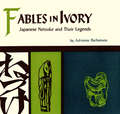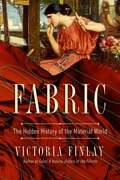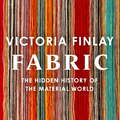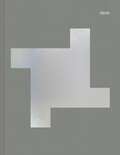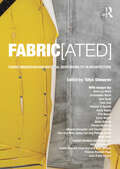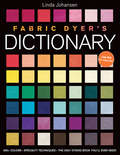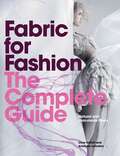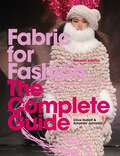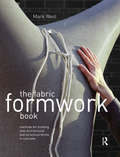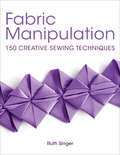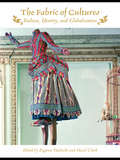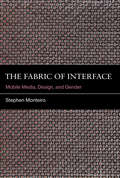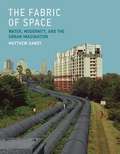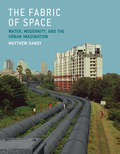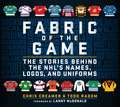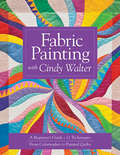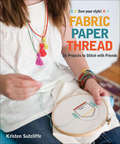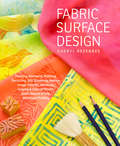- Table View
- List View
Fables in Ivory
by Adrienne BarbansonTo introduce these miniature sculptures to a wider audience and, at the same time, to tell some of the legends that inspired their creators, Adrienne Barbanson presents here a collection of superb photographs accompanied by a narrative text designed to enhance the reader's appreciation of this remarkable by relatively unfamiliar art.
Fables in Ivory
by Adrienne BarbansonTo introduce these miniature sculptures to a wider audience and, at the same time, to tell some of the legends that inspired their creators, Adrienne Barbanson presents here a collection of superb photographs accompanied by a narrative text designed to enhance the reader's appreciation of this remarkable by relatively unfamiliar art.
Fabric: The Hidden History of the Material World
by Victoria FinlayA magnificent work of original research that unravels history through textiles and cloth—how we make it, use it, and what it means to us.How is a handmade fabric helping save an ancient forest? Why is a famous fabric pattern from India best known by the name of a Scottish town? How is a Chinese dragon robe a diagram of the whole universe? What is the difference between how the Greek Fates and the Viking Norns used threads to tell our destiny? In Fabric, bestselling author Victoria Finlay spins us round the globe, weaving stories of our relationship with cloth and asking how and why people through the ages have made it, worn it, invented it, and made symbols out of it. And sometimes why they have fought for it. She beats the inner bark of trees into cloth in Papua New Guinea, fails to handspin cotton in Guatemala, visits tweed weavers at their homes in Harris, and has lessons in patchwork-making in Gee's Bend, Alabama - where in the 1930s, deprived of almost everything they owned, a community of women turned quilting into an art form. She began her research just after the deaths of both her parents —and entwined in the threads she found her personal story too. Fabric is not just a material history of our world, but Finlay's own journey through grief and recovery.
Fabric: The Hidden History of the Material World
by Victoria FinlayVictoria Finlay spins us round the globe, weaving stories of our relationship with cloth and completing the trilogy of books which began with her first bestseller Colour: Travels Through the Paintbox.How is a handmade fabric helping save an ancient forest?Why is a famous fabric pattern from India best known by the name of a Scottish town?How is a Chinese dragon robe a diagram of the whole universe?What is the difference between how the Greek Fates and the Viking Norns used threads to tell our destiny?In Fabric, bestselling author Victoria Finlay spins us round the globe, weaving stories of our relationship with cloth and asking how and why people through the ages have made it, worn it, invented it and made symbols out of it. And sometimes why they have fought for it.She beats the inner bark of trees into cloth in Papua New Guinea, fails to handspin cotton in Guatemala, visits tweed weavers at their homes in Harris, and has lessons in patchwork-making in Gee's Bend, Alabama - where in the 1930s, deprived of almost everything they owned, a community of women turned quilting into an art form.She began her research just after the deaths of both her parents - and entwined in the threads she found her personal story too. The book became her journey through grief and recovery. It is her own patchwork.'Subtle, compendious and rich ... an emotive and serious work of what you might call history on the distaff side' - James McConnachie, The Sunday Times'Dazzling ... Finlay's adventures, vividly recounted, make enthralling reading ... This book is equally an inspiration and an education' - Bel Mooney, Daily Mail'I am wildly impressed by the depth of her research and the stories she finds' - Alexandra Shulman, author of Clothes... And Other Things That Matter(P)2022 Hodder & Stoughton Limited
fabric: The fully illustrated history of the famous London club
by Joe MuggsAvailable in a first edition print run strictly limited to 4,000 copies, fabric tells the story of one of the most revered clubs in the history of dance music culture.fabric captures the journey of a small group of enthusiasts who, rebelling against the commercialisation of the rave scene, converted a derelict meat store in an unfashionable part of London into a venue that remains a cathedral for undiluted dance music with a global following.Featuring stories about the club's birth, struggles and successes, as well as rare photography and iconic artwork, and an oral history by Joe Muggs featuring over one hundred testimonies from the legendary DJs associated with fabric, this is a celebration of the colossal impact fabric has had on club culture over the last quarter of a century. Above all, it's a story about the misfits and visionaries who made it happen, the curators and resident DJs who have kept it true to its roots, and the experiences of clubbers on the dancefloor.
fabric: The fully illustrated history of the famous London club
by Joe MuggsAvailable in a first edition print run strictly limited to 4,000 copies, fabric tells the story of one of the most revered clubs in the history of dance music culture.fabric captures the journey of a small group of enthusiasts who, rebelling against the commercialisation of the rave scene, converted a derelict meat store in an unfashionable part of London into a venue that remains a cathedral for undiluted dance music with a global following.Featuring stories about the club's birth, struggles and successes, as well as rare photography and iconic artwork, and an oral history by Joe Muggs featuring over one hundred testimonies from the legendary DJs associated with fabric, this is a celebration of the colossal impact fabric has had on club culture over the last quarter of a century. Above all, it's a story about the misfits and visionaries who made it happen, the curators and resident DJs who have kept it true to its roots, and the experiences of clubbers on the dancefloor.
Fabric and Fiber Inventions: Sew, Knit, Print, and Electrify Your Own Designs to Wear, Use, and Play With
by Kathy CeceriIn this book you'll create your own fabric inventions as you learn to make wearables, playthings, and decorative items using textile arts--both old and new. Easy projects using will get you started knitting, adding color to your wardrobe with silkscreen and batik, and transforming old clothing into useful items. Then you'll find out how soft circuits can give your creations personality with light, sound, and motion. Fabric and Fiber Inventions will show you how to turn everyday materials into unique designs everybody will love.
FABRIC[ated]: Fabric Innovation and Material Responsibility in Architecture
by Tolya StonorovFABRIC[ated] examines fabric as a catalyst for innovation, reflection, change and transformation in architecture. This book explores the ways in which research and development of fabric can, and historically has, influenced and revolutionized architecture, teaching and design. Responsive, flexible, impermanent, fluid and adaptive—fabric interacts with, and influences architecture, offering innovative solutions and increased material responsibility. Foundation and theory chapters establish clear precedent and futures for fabric’s position in architectural discourse. The case study section examines 14 international projects through three different threads: Veiling, Compression and Tension. Case studies include a diverse range of projects from the HiLo unit at Nest and CAST’s fabric formed concrete projects to a discussion of the impact of fabric on SO-IL and Kennedy Violich Architect’s professional work, demonstrating new and fresh methods for addressing sustainability and social justice through the use of fabric in architecture. Through the work of the many authors of this book, we see fabric as drape, skin, veil, mold, concept and inspiration. Fabric, in its broadest definition, is an important and innovative material in the development of socially conscious architecture. Offering readers pedagogical and practical models for international projects highlighting fabric’s use in architecture, this book will appeal to the novice and the expert, architecture students and practitioners alike.
Fabric Dyer's Dictionary: 900+ Colors, Specialty Techiniques, The Only Dyeing Book You'll Ever Need!
by Linda JohansenEliminate the guesswork out of creating the color you want and dye happy with formulas for over 900 colors in this handy reference guide.A simple and straightforward approach to fabric dyeing makes playing with color fun and exciting. Learn the basics and try a variety of specialty techniques such as twisting, pleating, layering, and painting. Dye in lots from 1/4 yard to 1 yard, or use multipliers for more. Now you have Linda’s personal “recipe book” to mix any colors you can imagine. Learn special techniques like how to make rainbows, subtle gradations, and unique patterns using common brands of dye, and then use your hand-dyed fabric for any project from quilt making to wearables to fiber art.
Fabric for Fashion: Natural and Man-made Fibres
by Clive HallettFabric for Fashion: The Complete Guide is the only book specifically for fashion designers to explain the behaviour and properties of different fabrics. Fashion design is largely determined by how the fabrics work, move, feel and look. The most successful fashion designers are those who understand their materials, who match design skill with technical knowledge. This book bridges that gap by providing a mix of practical information and industry vocabulary, visually examining generic fabric types, discussing the characteristics of fabrics and showing how to exploit materials to push the boundaries of design.With stunning colour photographs that show how fashion designers, both past and present, have worked with fabrics, the book’s prime objective is to stimulate creative exploration of the relationship of fabrics to fashion.
Fabric for Fashion: The Complete Guide Second Edition
by Clive Hallett Amanda JohnstonAimed at fashion designers, Fabric for Fashion:The Complete Guide is unique in explaining the behaviour, properties and sustainability impacts of a wide range of natural and man-made fabrics. Design is determined by how fabrics work, move, feel and look. Increasingly and out of necessity, design is also led by how fabric choices affect our planet and its inhabitants. The most successful fashion designers are those who truly understand their materials, who match design skill with technical knowledge. This book offers guidance by providing a mix of practical information, including industry vocabulary, and a wealth of stunning visual examples showing how designers, both past and present, have worked with textiles. Highlights of this new edition include additional chapters on:- Sustainable fabrics and fashion- Smart fabrics- Product development- Biosynthetic fibres"This second edition of Fabric for Fashion offers refreshed information on sustainability and smart fabrics. Rather than tacking on a chapter to address these concerns, Hallett and Johnston address these topics appears in every chapter and subchapter, on subjects like fabrics' environmental impacts, for example, as well as notes on eco-friendly fabrics, how "smart" fabric translates into functional designs, the recyclability of individual fabrics, and more... A must for anyone who cares about the fate of fabrics and the goods they become, as well as the fate of our planet." - Booklist
Fabric for Fashion: The Complete Guide Second Edition
by Clive Hallett Amanda JohnstonAimed at fashion designers, Fabric for Fashion:The Complete Guide is unique in explaining the behaviour, properties and sustainability impacts of a wide range of natural and man-made fabrics. Design is determined by how fabrics work, move, feel and look. Increasingly and out of necessity, design is also led by how fabric choices affect our planet and its inhabitants. The most successful fashion designers are those who truly understand their materials, who match design skill with technical knowledge. This book offers guidance by providing a mix of practical information, including industry vocabulary, and a wealth of stunning visual examples showing how designers, both past and present, have worked with textiles. Highlights of this new edition include additional chapters on:- Sustainable fabrics and fashion- Smart fabrics- Product development- Biosynthetic fibres"This second edition of Fabric for Fashion offers refreshed information on sustainability and smart fabrics. Rather than tacking on a chapter to address these concerns, Hallett and Johnston address these topics appears in every chapter and subchapter, on subjects like fabrics' environmental impacts, for example, as well as notes on eco-friendly fabrics, how "smart" fabric translates into functional designs, the recyclability of individual fabrics, and more... A must for anyone who cares about the fate of fabrics and the goods they become, as well as the fate of our planet." - Booklist
Fabric for Fashion: Natural and Man-made Fibres
by Amanda Johnston Clive HallettFabric for Fashion: The Complete Guide is the only book specifically for fashion designers to explain the behaviour and properties of different fabrics. Fashion design is largely determined by how the fabrics work, move, feel and look. The most successful fashion designers are those who understand their materials, who match design skill with technical knowledge. This book bridges that gap by providing a mix of practical information and industry vocabulary, visually examining generic fabric types, discussing the characteristics of fabrics and showing how to exploit materials to push the boundaries of design.With stunning colour photographs that show how fashion designers, both past and present, have worked with fabrics, the book’s prime objective is to stimulate creative exploration of the relationship of fabrics to fashion.
The Fabric Formwork Book: Methods for Building New Architectural and Structural Forms in Concrete
by Mark WestConcrete is the most used man-made material in the world and is the fundamental physical medium for most of the world’s architecture and construction. The character of concrete is largely the product of the rigid moulds that have shaped it since its invention in antiquity. The advent of flexible moulds, however, marks a radical break from conventional practice – and conventional concrete architecture. The Fabric Formwork Book provides the first comprehensive handbook on the emerging technology of flexible moulds for reinforced concrete architecture. Written by the foremost expert in the field, this book takes a comprehensive and generous approach that includes technical, historical and theoretical aspects of the subject. The book: concentrates on simple flat-sheet formworks contains detailed technical descriptions of how to construct a wide range of formworks for various applications features case studies from around the world critiques the difficulties and advantages in each case it covers provides instruction and guidance on how to model and design fabric-formed structures includes the most comprehensive history of fabric formwork yet published features essays from guest expert authors, which explore the theoretical, historical, and poetic significance of flexibly formed architecture and structures discusses fabric formwork as an exemplary approach to sustainable construction through its simplicity and efficiency. Beautifully designed and illustrated with a superb range of images, diagrams and technical drawings, the book both informs and inspires. Speaking directly and plainly to professionals, students and academics, the language used is both clear and precise, and care is taken to avoid opaque technical or academic jargon. Technical terms, when used, are clearly described and a special glossary is included to make the book as widely accessible as possible.
Fabric Jewelry Wrapped, Braided & Sewn
by Heidi PridemoreTurn your favorite fabrics and fibers into fabulous jewelry! Whether you love sewing, quilting or jewelry making,Fabric Jewelry Wrapped, Braided & Sewnwill inspire you to use your favorite materials and techniques in new ways. If you love all three, you'll learn how to combine your passions to create unique jewelry. Look insideFabric Jewelry Wrapped, Braided & Sewnfor: step-by-step instructions for 19 stunning fabric and fiber beads and 20 gorgeous fabric jewelry projects, including pendants, bracelets and necklaces all of the jewelry-making tips and techniques you'll need to make every project a gallery of jewelry projects to inspire your own original designs sidebars and notes from sewing and craft expert Nancy Zieman sprinkled throughout the pages offer more expert advice! Find new inspiration in fabric and see what beautiful results you can create!
Fabric Manipulation: 150 Creative Sewing Techniques
by Ruth SingerThe award-winning textile artist presents her modern approach to 150 fabric manipulation techniques in this fully illustrated sewing guide. In Fabric Manipulation, Ruth Singer presents the most in-depth and comprehensive guide to sculptural and embellishing effects since Collette Wolff&’s The Art of Manipulating Fabric. Divided into three sections—Pleat and Fold, Stitch and Gather, Apply and Layer—Fabric Manipulation teaches sewists of all skill levels 150 creative sewing techniques with clear instruction, photos, and hundreds of full color diagrams. Ruth explains her innovative variations on traditional fabric manipulation techniques such as pleating, folding, gathering, smocking, quilting, trapunto and applique. She also offers inspirational project ideas for accessories and home décor that demonstrate practical uses of fabric manipulation.
The Fabric of Cultures: Fashion, Identity, and Globalization
by Eugenia Paulicelli Hazel ClarkFashion is both public and private, material and symbolic, always caught within the lived experience and providing an incredible tool to study culture and history. The Fabric of Cultures examines the impact of fashion as a manufacturing industry and as a culture industry that shapes the identities of nations and cities in a cross-cultural perspective, within a global framework. The collected essays investigate local and global economies, cultures and identities and the book offers for the first time, a wide spectrum of case studies which focus on a diversity of geographical spaces and places, from global capitals of fashion such as New York, to countries less known or identifiable for fashion such as contemporary Greece and soviet Russia. Highly illustrated and including essays from all over the world, The Fabric of Cultures provides a comprehensive survey of the latest interdisciplinary scholarship on fashion, identity and globalisation.
The Fabric of Interface: Mobile Media, Design, and Gender (The\mit Press Ser.)
by Stephen MonteiroTracing the genealogy of our physical interaction with mobile devices back to textile and needlecraft culture. For many of our interactions with digital media, we do not sit at a keyboard but hold a mobile device in our hands. We turn and tilt and stroke and tap, and through these physical interactions with an object we make things: images, links, sites, networks. In The Fabric of Interface, Stephen Monteiro argues that our everyday digital practice has taken on traits common to textile and needlecraft culture. Our smart phones and tablets use some of the same skills—manual dexterity, pattern making, and linking—required by the handloom, the needlepoint hoop, and the lap-sized quilting frame. Monteiro goes on to argue that the capacity of textile metaphors to describe computing (weaving code, threaded discussions, zipped files, software patches, switch fabrics) represents deeper connections between digital communication and what has been called “homecraft” or “women's work.” Connecting networked media to practices that seem alien to media technologies, Monteiro identifies handicraft and textile techniques in the production of software and hardware, and cites the punched cards that were read by a loom's rods as a primitive form of computer memory; examines textual and visual discourses that position the digital image as a malleable fabric across its production, access, and use; compares the digital labor of liking, linking, and tagging to such earlier forms of collective production as quilting bees and piecework; and describes how the convergence of intimacy and handiwork at the screen interface, combined with needlecraft aesthetics, genders networked culture and activities in unexpected ways.
The Fabric of Space
by Matthew GandyWater lies at the intersection of landscape and infrastructure, crossing between visible and invisible domains of urban space, in the tanks and buckets of the global South and the vast subterranean technological networks of the global North. In this book, Matthew Gandy considers the cultural and material significance of water through the experiences of six cities: Paris, Berlin, Lagos, Mumbai, Los Angeles, and London. Tracing the evolving relationships among modernity, nature, and the urban imagination, from different vantage points and through different periods, Gandy uses water as a lens through which to observe both the ambiguities and the limits of nature as conventionally understood. Gandy begins with the Parisian sewers of the nineteenth century, captured in the photographs of Nadar, and the reconstruction of subterranean Paris. He moves on to Weimar-era Berlin and its protection of public access to lakes for swimming, the culmination of efforts to reconnect the city with nature. He considers the threat of malaria in Lagos, where changing geopolitical circumstances led to large-scale swamp drainage in the 1940s. He shows how the dysfunctional water infrastructure of Mumbai offers a vivid expression of persistent social inequality in a postcolonial city. He explores the incongruous concrete landscapes of the Los Angeles River. Finally, Gandy uses the fictional scenario of a partially submerged London as the starting point for an investigation of the actual hydrological threats facing that city.
The Fabric of Space: Water, Modernity, and the Urban Imagination (The\mit Press Ser.)
by Matthew GandyA study of water at the intersection of landscape and infrastructure in Paris, Berlin, Lagos, Mumbai, Los Angeles, and London.Water lies at the intersection of landscape and infrastructure, crossing between visible and invisible domains of urban space, in the tanks and buckets of the global South and the vast subterranean technological networks of the global North. In this book, Matthew Gandy considers the cultural and material significance of water through the experiences of six cities: Paris, Berlin, Lagos, Mumbai, Los Angeles, and London. Tracing the evolving relationships among modernity, nature, and the urban imagination, from different vantage points and through different periods, Gandy uses water as a lens through which to observe both the ambiguities and the limits of nature as conventionally understood. Gandy begins with the Parisian sewers of the nineteenth century, captured in the photographs of Nadar, and the reconstruction of subterranean Paris. He moves on to Weimar-era Berlin and its protection of public access to lakes for swimming, the culmination of efforts to reconnect the city with nature. He considers the threat of malaria in Lagos, where changing geopolitical circumstances led to large-scale swamp drainage in the 1940s. He shows how the dysfunctional water infrastructure of Mumbai offers a vivid expression of persistent social inequality in a postcolonial city. He explores the incongruous concrete landscapes of the Los Angeles River. Finally, Gandy uses the fictional scenario of a partially submerged London as the starting point for an investigation of the actual hydrological threats facing that city.
Fabric of the Game: The Stories Behind the NHL's Names, Logos, and Uniforms
by Chris Creamer Todd RadomAn in-depth look into the origins of how each NHL team was named, received their logo and design, with interviews by those responsible. Written by those most knowledgeable, you'll learn why every hockey team to every play in the National Hockey League looks the way it does. Nothing unites or divides a random assortment of strangers quite like the hockey team for which they cheer. The passion they hold within them for the New York Rangers, Toronto Maple Leafs, Montreal Canadiens, or Boston Bruins allows them to look past any differences which would have otherwise disrupted a perfectly fine Thanksgiving dinner and channels it into a powerful, shared admiration for their team. We decorate our lives with their logos, stock our wardrobe with their jerseys, and, in some cases, even tattoo our bodies with their iconography and colors. They&’re so ingrained in our lives we don&’t even think to ask ourselves why Los Angeles celebrates royalty; why Buffalo cheers for not one, but two massive cavalry swords; or why the Broadway Blueshirts named themselves for a law enforcement agency in Texas (or why they even wear blue shirts, for that matter). All that and more is explored in Fabric of the Game, authored by two of the sports world&’s leading experts in team branding and design: Chris Creamer and Todd Radom. Tapping into their vast knowledge of the whys and hows, Creamer and Radom explore and share the origin stories behind these and more, talking directly to those involved in the decision processes and designs of the National Hockey League&’s team names, logos, and uniforms, pouring through historical accounts to find and deliver the answers to these questions. Learn more about the historied Detroit Red Wings and Chicago Blackhawks, as well as the lost but not forgotten Hartford Whalers and Quebec Nordiques, all the way to the lesser-known Kansas City Scouts and Philadelphia Quakers. Whichever team you pledge allegiance, Fabric of the Game covers them in-depth with research and knowledge for any hockey fan to enjoy.
Fabric Painting for Fun!
by Anne SchreiberIn this book for beginners, you will learn about the tools and techniques for fabric painting, as well as the ways you can make your materials look really unique and exciting. Learn about fabric crafts from around the world, how to make natural dyes, and how to make truly beautiful works of art.
Fabric Painting with Cindy Walter: A Beginner's Guide
by Cindy Walter“This is a wonderful way to start experimenting with fabric paint and all the effects you can create using different techniques.” —The Applique SocietyExplore a variety of fabric painting techniques and add a distinctive touch to your quilts. You’ll learn how to create sun prints and use resist techniques, as well as how to paint a Hawaiian quilt and a traditional block quilt. Try colorwashing, scrunching, and salting methods to create uniquely personal fabrics. With fun projects, basic information about color, and tips on different types of paints and supplies, the award-winning author of Snippet Sensations and other popular titles encourages you to experiment, be playful, and get creative!
Fabric Paper Thread: 26 Projects to Stitch with Friends
by Kristen SutcliffeEmbroider fabric or paper to create 26 colorful projects you can make to use, wear, give, and brighten your space.Whether you’re super crafty or have never even picked up a needle and thread, you’ll find something here that you just have to make! Ever gotten bored with one of your tee shirts or tote bags? Learn how to transform them into unique pieces all your own using embroidery stitches and super simple appliqué. Craft a fab necklace, a cute cover for a boring notepad, or a chic bracelet in no time at all!• Make a quick and easy gift for a friend or for yourself. Choose a no-sew project like a colorful tasseled bead necklace or a cool notepad covered in your fave fabric• Crafts to do with your friends or on the go—take them on vacation, to camp, or anyplace you goPraise for Fabric Paper Thread“Sutcliffe’s first book is an approachable set of projects, mostly embroidery-based...Her aesthetic is charming: simple, often patterned, designs with easy-to-stitch lines, with just enough trendiness to appeal. . . . This book is a lovely gift to the supervised young crafter.” —Publishers Weekly“All of the projects are cool and fun, and appeal to anyone. Though most of the pictures have girls doing the projects, the projects aren’t girly and my son didn’t consider any of the projects “off limits” for a boy. . . . Fabric Paper Thread is full of ideas. Many of these projects will make great road trip and vacation projects, and I’m looking forward to trying them out with my kids.” —Sew A Straight Line
Fabric Surface Design: Painting, Stamping, Rubbing, Stenciling, Silk Screening, Resists, Image Transfer, Marbling, Crayons & Colored Pencils, Batik, Nature Prints, Monotype Printing
by Cheryl RezendesSensational sewing projects demand fabulous fabrics! Fiber artist Cheryl Rezendes shows you how to create an astonishing array of surface designs, simply and safely, using textile paints and printing ink. She covers a wide variety of techniques: stamping, ancient Japanese Shibori, silkscreen, soy wax and flour resist, image transfer, marbling, nature printing, foils and metal leaf, and more. Step-by-step photographs illustrate every technique, and Rezendes includes innovative suggestions on how to combine and layer techniques for stunningly original results.
